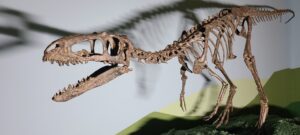How Do You Pronounce Dinosaur Names Correctly?
To pronounce dinosaur names correctly, break the word down into syllables and emphasize the correct parts. Use phonetic guides or pronunciation keys found in scientific publications or trustworthy educational resources.
Engaging with the prehistoric world, naming dinosaurs is an exciting bridge between ancient life and modern fascination.
Pronouncing these awe-inspiring names conveys respect for their Greek or Latin roots and enhances the immersive experience of discovery.
Enthusiasts from casual museum-goers to academic experts can appreciate the significance of accurate pronunciation.
By dissecting complex names into manageable parts, one can unlock a new level of understanding and appreciation for these magnificent creatures.
Whether it’s the towering “Brachiosaurus” or the fierce “Velociraptor,” knowing how to say their names enriches conversations about these extinct giants.
Committing to this small educational endeavor helps preserve the integrity and history of paleontology.

Demystifying Dinosaur Pronunciation
Ever stumbled upon the name of a dinosaur and felt utterly baffled?
Dinosaur names can be tricky, with their roots in ancient languages and scientific terms.
But fear not!
We’re here to guide you through the twists and turns of dinosaur nomenclature.
Say goodbye to pronunciation blunders and hello to a world where Tyrannosaurus rolls off the tongue.
Breaking Down Complex Names
To correctly pronounce dinosaur names, split them into smaller chunks. Look for familiar patterns or sounds. This approach simplifies seemingly intimidating names.
Often, dinosaur names are a mix of Greek and Latin words that describe their features or where they were found.
- Example: Velociraptor breaks down to velox (swift) + raptor (thief).
- Pronunciation tip: Emphasize the syllable that seems most natural.
Use the following table to practice breaking down complex names:
| Dinosaur Name | Breakdown | Pronunciation |
|---|---|---|
| Pachycephalosaurus | Pachy + cephalo + saurus | pack-ee-SEFF-uh-low-SORE-us |
| Archaeopteryx | Archaeo + pteryx | ar-kee-OP-ter-iks |
Common Pronunciation Pitfalls
Common mistakes can trip you up.
Here’s a list to keep in mind:
- Not stressing the correct syllable: This can change the sound of the name.
- Ignoring silent letters: Some names have silent parts. For instance, the ‘p’ in Pteranodon is silent.
- Long Vowel Sounds: These often get shortened. Remember, ‘saur’ sounds like ‘sore’, not ‘sar’.
Train your ear by listening to experts. Online resources offer audio pronunciations for clarity. Books on dinosaurs sometimes include phonetic spelling. With a little practice, you will be a dino-naming pro!
Origins Of Dinosaur Names
Dinosaur names awaken our curiosity and transport us back in time. These names come from ancient languages. They tell a story. They describe what the dinosaur looked like or where it was found.
Understanding these names can be like unlocking secrets from the past. Let’s explore the roots of these prehistoric giants’ names.
Roots In Ancient Greek And Latin
Most dinosaur names have Greek or Latin origins. Scientists use these languages to create names that last forever. These ancient words become clues. They help us say the names right.
- “Saurus” means lizard in Greek.
- “Raptor” means thief or robber in Latin.
For example, Velociraptor means ‘swift thief.’ It combines Latin for ‘swift’ and ‘thief.’ This dinosaur was indeed a fast-moving predator. Knowing the roots helps us pronounce dinosaur names correctly.
Understanding Etymology For Better Pronunciation
Etymology is the study of words and their history. Knowing where a name comes from can make pronunciation easier. It’s like a puzzle. When you connect the pieces, you can say the names right.
| Dinosaur Name | Meaning | How to Pronounce |
|---|---|---|
| Triceratops | Three-horned face | Try-SER-a-tops |
| Brachiosaurus | Arm lizard | BRA-kee-o-sawr-us |
Break down the name. Look at its parts. Say each part slowly. Then say them together. This way, you can master dinosaur names.
Pronunciation Guidelines
Pronouncing dinosaur names is not just a challenge for kids, but for adults too. These prehistoric titans have names that are as complex as they are fascinating.
To sound like a paleontologist, let’s explore some tips to get those dinosaur names rolling off your tongue correctly.
Emphasis On Syllables
Correct pronunciation often depends on knowing where to put the stress in a word. Most dinosaur names have Latin or Greek roots.
This means we usually emphasize the second or third syllable. For example, ‘VELOciraptor’ stresses the ‘lo’, while ‘brontoSAURUS’ accentuates the ‘saur’.
- Tyrannosaurus: tie-RAN-oh-sore-us
- Stegosaurus: steg-oh-SORE-us
- Triceratops: try-SER-ah-tops
Vowel Sounds In Dinosaur Names
Vowels can be tricky since they change sound depending on the language of origin. In dinosaur names, a single letter like ‘a’ can sound like ‘ah’, ‘aa’, or ‘ae’. Learning the basic vowel sounds helps nail the pronunciation. Here’s a quick guide:
| Vowel | Sound |
|---|---|
| A | ‘ah’ as in Allosaurus |
| E | ‘ee’ as in Stegosaurus |
| I | ‘eye’ as in Iguanodon |
| O | ‘oh’ as in Brontosaurus |
| U | ‘oo’ as in Utahraptor |
Consonant Rules And Exceptions
Consonants in dinosaur names mostly follow English pronunciation rules. However, ‘p’ and ‘c’ can be silent sometimes, as in Pterodactyl and Cnidaria. The ‘ch’ in Archaeopteryx is like ‘k’, not ‘ch’ as in ‘church’. Keep an eye out for these special cases:
- ‘P’ is silent in Pterosaur.
- ‘C’ sounds like ‘k’ in Ceratosaurus.
- The ‘g’ in Giganotosaurus is ‘g’ as in ‘gigantic’, not ‘g’ as in ‘gin’.
Practice Through Examples
Embarking on the journey of pronouncing dinosaur names can be daunting, yet incredibly exciting. Mesmerizing creatures of the past, dinosaurs stir up curiosity with their complex names derived from ancient Greek and Latin.
The key to mastery? Practice, and lots of it. With a focus on Practice Through Examples, this section eases the process by breaking down and sounding out some of the most well-known, along with some obscure dinosaur names, so everyone can become a dino-name expert.
Sounding Out Popular Dinosaur Names
- Tyrannosaurus Rex: Tie-RAN-oh-sore-us REX
- Velociraptor: Veh-LOSS-ih-rap-tor
- Stegosaurus: Steg-oh-SORE-us
- Triceratops: Try-SERRA-tops
Memorize these sounds. Break them into parts. Say them out loud. This is your formula for conquering the most iconic dino names. Many share similar suffixes like ‘-saurus’ meaning ‘lizard’, making the learning curve a little easier.
Lesser-known Dinosaurs: A Pronunciation Challenge
Ready for a bigger challenge? Here are some of the lesser-known dinosaur names that will test your pronunciation skills.
| Dinosaur Name | How to Pronounce |
|---|---|
| Parasaurolophus: | Para-saw-RO-lo-fus |
| Pachycephalosaurus: | Pack-ee-SEFF-ah-lo-sore-us |
| Archaeopteryx: | Ar-kee-OP-ter-ix |
| Deinonychus: | Dye-NON-ih-kus |
Approach each syllable methodically. Break them down. Watching videos of paleontologists can help. Cross-referencing with phonetics guides is also beneficial.
Tools And Resources
Stepping into the prehistoric world of dinosaurs is thrilling. Saying their names correctly adds to the excitement.
Many tools and resources can help with this. Let’s dive into some of the best options available to every dinosaur enthusiast.
Apps And Websites For Pronunciation
Modern technology brings ease to learning dinosaur names. Apps and websites offer pronunciation guides. They are interactive and user-friendly.
Examples include:
- DinoPronouncer: An app providing audio pronunciations.
- Prehistoric Vocalizer: A website with a vast dinosaur library.
- SpeakDino: An educational platform offering games and quizzes.
All tools feature clear audio clips. They show phonetic spellings. Users can listen and repeat. This method improves pronunciation with practice.
Books And Guides For Enthusiasts
Books and guides offer detailed information alongside pronunciation keys. They are perfect for those who prefer physical resources. Key titles include:
| Book Title | Author | Features |
|---|---|---|
| Dinosaur Name Pronunciation Guide | Dr. Rex Claws | Illustrations, phonetics, dino facts |
| The Dino Linguist Handbook | Prof. Trixie Raptor | Pronunciation exercises, history |
| Jurassic Pronouncer: A Field Guide | Sammy Stegosaurus | Outdoor tips, audio CD |
Books like these help readers learn at their own pace. They often include tips on accentuating tricky dino names. Readers can visualize pronunciation through phonetic spellings.
Expert Insights
Welcome to our in-depth section on ‘Expert Insights’ into the pronunciation of dinosaur names. Understanding these names can be challenging. Our aim is to make them accessible and easier to say.
Tips From Paleontologists
Let’s dive into tips from those who know dinosaur names best:
- Break the name into syllables. Think of it like a rhythm.
- Focus on accented syllables; most dinosaur names have one.
- Use online pronunciations from reputable museums for guidance.
- Learn the Greek or Latin roots since many names come from these languages.
How Science Influences Pronunciation
The pronunciation of dinosaur names often reflects their scientific origins. Here’s how:
| Scientific Influence | Impact on Pronunciation |
|---|---|
| Root Language | Names follow Latin or Greek pronunciation rules. |
| Anatomy References | Words describe physical features, influencing emphasis. |
| Discoverer’s Notation | Some names include references to scientists, using their surnames’ pronunciations. |
For example, Velociraptor stems from the Latin ‘velox’ (swift) and ‘raptor’ (thief). Therefore, focus on these pronunciation cues for accuracy.
Frequently Asked Questions On How Do You Pronounce Dinosaur Names Correctly?
What Is The Hardest Dinosaur Name To Pronounce?
One of the hardest dinosaur names to pronounce is Micropachycephalosaurus. This lengthy name presents a challenge due to its uncommon combination of phonetic sounds.
What Are 23 Letter Dinosaur Names?
Micropachycephalosaurus is a 23-letter dinosaur name, known for its long, challenging spelling. This herbivore lived during the Late Cretaceous period.
What Dinosaur Names Have A Silent P?
Dinosaur names with a silent ‘P’ include Pterosaurs, Plesiosaurs, and Psittacosaurus. These ancient reptiles showcase the phenomenon in paleontology nomenclature.
What Is The Pronunciation Of Tyrannosaurus Rex?
The pronunciation of Tyrannosaurus rex is “Tie-RAN-oh-SORE-us recks. “
Conclusion
Mastering the proper pronunciation of dinosaur names can feel like a colossal task. Yet, armed with phonetic breakdowns and audio examples, anyone can become proficient.
Tackling these ancient tongue-twisters adds fun and accuracy to discussions about these fascinating prehistoric creatures.
Embrace the challenge and impress your fellow dino enthusiasts with your newfound skills. Keep practicing, and those daunting names will soon roll off your tongue with ease.


